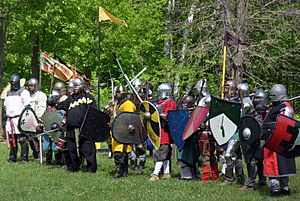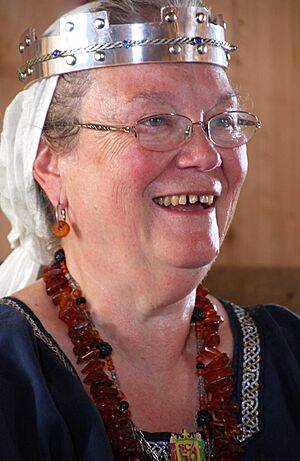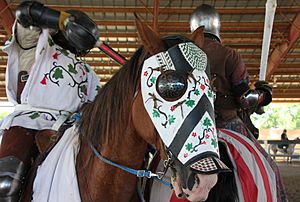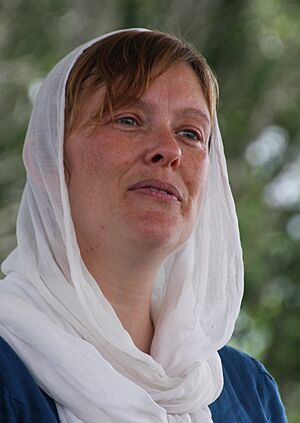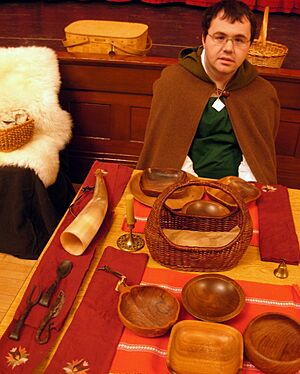Society for Creative Anachronism facts for kids
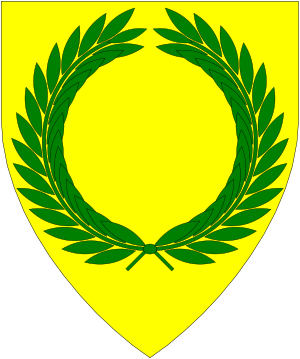 |
|
| Founded | May 1, 1966 in Berkeley, California, U.S. |
|---|---|
| Type | 501(c)(3) non-profit corporation |
| Focus | Historical reenactment |
| Headquarters | Milpitas, California |
|
Area served
|
Worldwide |
|
Volunteers
|
About 30,000 |
The Society for Creative Anachronism (SCA) is a worldwide group. It focuses on studying and bringing to life medieval European cultures. This includes history from before the 17th century. People in the SCA often say they recreate the Middle Ages "as they ought to have been." They pick the parts of history that are most interesting to them. The SCA started in 1966. It is a non-profit group that helps people learn. As of 2020, it had over 20,000 members. About 60,000 people take part in its activities.
Contents
How the SCA Started
The SCA began with a party in a backyard. This party was held by Diana Paxson, a student who loved medieval studies. It happened in Berkeley, California, on May Day in 1966. The party started with a "Grand Tournament." People wore helmets and costumes. They used fake weapons like plywood swords. The party ended with a parade. Everyone sang "Greensleeves" as they walked.
The SCA still counts its years from that first party. They call it Anno Societatis, which means "in the Year of the Society." For example, the year from May 1, 2009, to April 30, 2010, was A.S. XLIV (Year 44). The name "Berkeley Society for Creative Anachronism" was thought up by Marion Zimmer Bradley. She was an early member and a science fiction writer. The group needed an official name to book a park. Later, "Berkeley" was removed as the group grew.
In 1968, the idea of the SCA spread. A book called A Handbook for the Current Middle Ages was made. It showed people how to start their own SCA groups. Soon, new local chapters began to form. By the end of 1969, the SCA had three main regions, called "kingdoms." These were the West Kingdom, East, and Middle. All other SCA kingdoms today grew from these first three.
What People Do in the SCA
The SCA offers many fun activities. These include:
- Armored combat (like knights fighting)
- Fencing (with safe swords)
- Archery (shooting bows and arrows)
- Horseback riding activities
- Feasting (eating medieval-style food)
- Dancing
- Recreating medieval arts and sciences
People also learn crafts, music, and theater from the Middle Ages. They study heraldry, which is about coats of arms. They also practice scribal arts, like calligraphy (fancy writing) and making decorated books. Members can even create their own medieval-style name and coat of arms. SCA scribes make beautiful scrolls. These scrolls are given as awards for achievements.
Most local SCA groups have weekly practices. These include fighter practices, archery, and dance. Many groups also have "Arts & Science" nights. Here, members work on different crafts. Some larger groups have "war practices." This is where fighters practice group tactics for big events.
The SCA encourages members to wear clothing from before the 17th century. This is called "Garb." It doesn't have to be perfectly accurate. The main idea is to avoid looking too modern. Members use modern items for safety or comfort. For example, they wear glasses or use safe materials for weapons. SCA events are different from most Renaissance fairs. SCA events are for members and their guests. They focus on learning and history. Renaissance fairs are usually for profit and open to the public.
SCA Events and Gatherings
The SCA holds many events. These are for its members and their guests. Some of the biggest events are called "wars." These wars bring together members from many different kingdoms.
- Pennsic War: This is the largest SCA event. It happens every year. It is a "war" between the East Kingdom and the Middle Kingdom.
- Estrella War: This war was held for over 30 years. It was mainly between the Kingdom of Atenveldt and the Kingdom of the Outlands. It was usually held near Phoenix, Arizona. Thousands of people attended each year. It was canceled permanently in 2021.
- Other Wars: Other yearly SCA wars include Gulf Wars, Great Western War, and War of the Lillies.
Many kingdoms also have their own yearly events. These include Crown Tournament and Coronation. Local groups often have their own traditional events too. These might be arts and sciences competitions or holiday feasts. Some groups also host "collegia" or "symposia." These are like workshops where members take classes. They learn about medieval arts, sciences, and other SCA topics.
How the SCA is Organized
SCA's Main Structure
The SCA is a non-profit group. Its main office is in Milpitas, California. It is run by a board of directors. These directors are chosen by the members. They help manage the SCA's business. They also handle rules and safety. Because the SCA is worldwide, it has groups in other countries too. These groups work with the main board. They also make their own decisions based on local laws.
SCA's Local Groups
The SCA is divided into large areas called kingdoms. Inside these kingdoms, there are smaller groups. These include Principalities, Baronies, and Shires. Each type of group has different numbers of members.
- Kingdom: A large area ruled by a King and Queen. They cover several U.S. states or Canadian provinces.
- Principality: A large area within a kingdom. It is ruled by a Prince and Princess.
- Barony: An area run by a Baron and/or Baroness. They represent the King and Queen.
- Shire: A local group that reports to a kingdom or principality.
- Canton: A local group that reports through a barony.
- College: A group based at a school or university.
- Stronghold: A group based at a military base.
- Port: A group based on a military ship at sea.
SCA groups are active all over the United States, Canada, Europe, Australia, Japan, South Africa, and New Zealand. There are also groups in places like China, Israel, and Thailand.
The SCA Kingdoms
There are twenty SCA Kingdoms. They cover different parts of the world. Here are some examples:
- The West Kingdom was the first kingdom, started in 1966. It includes Northern California, parts of Nevada, Alaska, Japan, Korea, and the Pacific Rim.
- The Kingdom of the East started in 1968. It covers many eastern U.S. states and parts of eastern Canada.
- The Middle Kingdom started in 1969. It includes Ohio, Indiana, Illinois, and parts of Kentucky and Iowa.
- The Kingdom of Atenveldt started in 1971. It now covers the state of Arizona.
- The Kingdom of Lochac started in 2002. It covers all of Australia and New Zealand.
SCA Officers and Roles
The SCA has many officers. Their titles are based on medieval roles. These officers help run the group at all levels.
- Seneschal: This person is like the president of the group. They manage the group's activities.
- Chancellor of the Exchequer: This is the treasurer. They handle all the money for the group.
- Knight Marshal: This officer supervises all combat activities. This includes armored combat, fencing, and archery.
- Minister of Arts and Sciences: This person helps organize classes and demonstrations. They help members learn medieval arts and sciences.
- Herald: This officer helps members create and register their medieval names and coats of arms.
- Chatelaine: This person welcomes new members. They help them get started in the SCA. They might even lend out costumes.
- Marshal: These officers supervise specific combat activities. They make sure everyone is safe.
- Constable: They handle public safety and security at events.
- Chronicler: This person creates and edits the group's newsletter.
- Minister of Children: This officer arranges activities for kids and youth at events.
- Historian: This person records the history of the group.
- Webminister: This officer manages the group's website.
- Social Media Officer: This person handles the group's social media pages.
SCA Group Culture
SCA members enjoy many activities. They learn about combat, chivalry, and archery. They also study heraldry, horseback riding, and making costumes. Many members enjoy cooking, metalworking, woodworking, and leather crafting. They also learn music, dance, calligraphy, and fiber arts.
Creating a Persona
To make history come alive, SCA members create a persona. This is a character that could have lived in medieval times. For new members, a persona might just be a costume and a name. Other members might create a detailed backstory for their character. The goal is to have a character that fits a real historical time and place.
The SCA has experts who help members choose a good persona name. The rules say that names can come from cultures known to medieval Europeans. So, you might find members with Saracen, Chinese, or Japanese personas. However, you cannot claim to be a famous historical person like Genghis Khan or Queen Elizabeth I. You also can't use the persona of another SCA member or a well-known fictional character like Robin Hood.
SCA Heraldry
A big part of the SCA is its system of Heraldry. Members can apply to register a name and a device (like a personal symbol) for their persona. SCA heralds check these for uniqueness and if they fit the historical period. This system helps keep track of everyone's unique identity within the SCA. Heralds also announce people at tournaments and organize combat lists.
SCA Royalty
The SCA has ceremonial rulers. These are Kings and Queens, and Princes and Princesses. They are chosen by winning tournaments in SCA armoured combat. Barons and Baronesses are usually chosen by the King and Queen.
One of the main jobs of the King and Queen is to give awards. These awards recognize members for their achievements. Awards can be for things like helping the group, excelling in arts and sciences, or being skilled in combat. Some awards give the person a new title, like "Lord," "Lady," "Baron," or "Duchess."
How Rulers are Chosen
Each SCA kingdom is "ruled" by a King and Queen. They are chosen by winning a Crown Tournament. This tournament is a special armored combat competition. The winner and their partner become the "Crown Prince and Princess." They learn from the current King and Queen for a few months. Then, they become the new King and Queen.
This way of choosing rulers is not how real medieval monarchs were chosen. However, there are old stories and games that inspired it. For example, in the Middle Ages, there were "mock king" games. Some of these involved combat.
Peerage Orders
The highest titles in the SCA belong to the current and former royalty. Below them are the "peerages." These are the highest awards a person can receive. The SCA has four main peerage orders:
- Order of the Chivalry: For skill in armored combat. Members are called Knights or Masters of Arms.
- Order of the Laurel: For skill in arts and sciences.
- Order of the Pelican: For outstanding service to the SCA.
- Order of Defense: For skill in rapier (fencing) combat.
In some kingdoms, the Order of the Rose is also considered a peerage. This order is made up of former Queens.
Becoming a Peer
Peerages are given by the King and Queen of a kingdom. They usually ask the advice of other members of that peerage. For example, to become a Knight, a current Knight (often the King) must perform a special ceremony.
SCA's Impact on Culture
The SCA has been mentioned in many books.
- In Number of the Beast (1980) by Robert A. Heinlein, an SCA tournament is shown where battles are fought to the "death."
- In Ariel (1983) by Steven R. Boyett, characters who were former SCA members survive a world where technology stops working. They use their SCA skills.
- The novel The Folk of the Air by Peter S. Beagle was inspired by early SCA events.
- In S. M. Stirling's Emberverse series, SCA members' skills become very important when modern technology stops working.
- Murder at the War by Mary Monica Pulver is a mystery novel set at the SCA's largest event, Pennsic War.
- In David Weber's 1996 novel Honor Among Enemies, a character mentions her uncle is an SCA member.
- In May 1999, The Onion (a satirical newspaper) ran a funny article titled "Society for Creative Anachronism Seizes Control of Russia."
- In 3001: The Final Odyssey (1997) by Arthur C. Clarke, the SCA is still active in the year 3001.
- In Christopher Stasheff's "Warlock" series, people on a planet are descended from SCA participants.
- In John Ringo's The Council Wars series, characters with SCA experience help society recover after losing technology.


